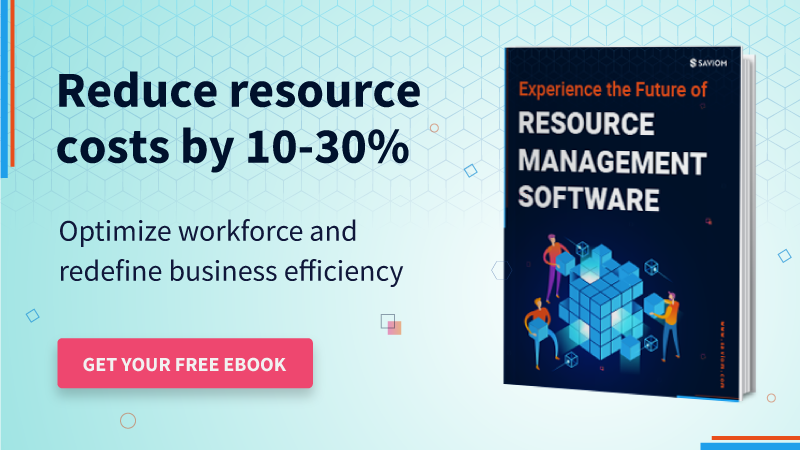“By failing to prepare, you are preparing to fail.”- By Benjamin Franklin.
The statement above is relevant for every organization, regardless of size and industry. Without appropriate planning, organizations will face issues like skill shortages, last-minute hiring, project delays, client dissatisfaction, etc. As a result, they will not be able to meet their long-term goals and maintain profitability.
Therefore, developing a comprehensive workforce management strategy is crucial for companies to succeed in a competitive business environment.
Operational workforce planning, a subset of workforce planning, is a fundamental ingredient that helps organizations acquire, retain, and deploy a skilled resource pool.
It enables businesses to anticipate labor requirements and assign the most competent resources to the appropriate projects at the right time and cost. It also improves employee productivity, enhances organizational efficiency and lays the groundwork for companies to reach their strategic goals.
This blog post explains the key business benefits of operational workforce planning.
Let’s begin with the basics.
Definition of operational workforce planning
Operational workforce planning involves setting short-term, realistic goals that help organizations achieve their strategic business objectives. It’s a roadmap that outlines the daily, weekly, and monthly activities that every department or team must complete to reach their business targets.
It enables organizations to set a benchmark that helps them recognize operational inefficiencies and optimize their internal processes accordingly.
Usually, companies that tend to think long-term often create operational plans for the entire fiscal year. Meanwhile, others make operational plans on a quarterly or half-yearly basis.
When one compares operational planning vs. strategic workforce planning, the primary difference between the two is the purpose, scope, and timeline. An operational plan focuses on immediate business priorities; however, a strategic plan focuses on long-term value-driven differentiation that helps organizations gain a competitive edge.
Read More: What Is Operational Workforce Planning and Its Importance?
An operational planning example:
An engineering equipment manufacturing plant plans to increase its production by 50% in the next three years. The company has identified the critical areas of focus that will help them achieve its targets- procurement, manufacturing, warehousing, and distribution. The plant installs new equipment, hires additional employees to operate the machinery, and strengthens its supply chain to meet the increase in its production capabilities. They also create an operational plan which details the daily requirements of every department and ensures that every resource (human and non-human) is optimally utilized against its capacity.
The objectives of operational planning are:
- Provide organizations with a blueprint for their daily operations that helps them achieve the strategic plan’s objectives.
- Enables firms to maximize their operational efficiency.
- Reduce manufacturing costs and overheads by optimizing processes and methods.
Now let’s understand the business benefits of operational planning in detail.
What are the business benefits of operational workforce planning?
Implementing an operational plan can help organizations understand how to achieve their long-term goals efficiently. Here are the business benefits of operational workforce planning:
Provides data-driven insights into demand vs. supply gap
An operational workforce plan provides organizations with the requisite foresight that helps them identify the gaps between demand vs. supply in advance. Accordingly, managers can proactively take appropriate resourcing treatment to bridge the gap.
For example, managers can utilize capacity vs. demand reports to identify skill shortages and implement measures such as retraining/upskilling, out rotation and backfill strategy, or hiring to address the bottleneck. Similarly, they can ensure that excess resources are not wasted by initiating training programs, shadowing opportunities, bringing forward future work, or selling the extra capacity at discounted rates.
Streamlines labor planning for seasonal & market changes
Certain industries experience seasonal demand fluctuations. Therefore, understanding daily operations and forecasting current and pipeline demand can help managers prepare a contingent workforce to handle seasonal peaks and troughs effectively. In addition, an on-demand workforce comes in handy when companies implement cost-cutting measures to tackle market changes like sudden price surges. This way, companies can streamline labor planning and reduce administrative overheads.
A perfect example of seasonal demand is the sudden peak of activities that accounting and auditing firms face at the end of each financial year. During this period, they have to manage the new client requests, prepare year-end tax filings, and certify balance sheets. Audit firms can use an on-demand contingent workforce during the peak season to fulfill these seasonal demands instead of hiring expensive permanent resources. As a result, it can help them significantly reduce resourcing costs without compromising quality.
Provides a roadmap to achieve strategic business goals
Operational planning provides an accurate high-level perspective of whether the company is on track to achieve its long-term strategic goals. If they are off track, they can take corrective measures ahead of time. For example, suppose the management discovers that they are falling short of daily objectives. In that case, managers can swiftly review the KPIs, determine where extra training or support is required, and implement a solution.
Operational plans are more limited in scope since they focus on the minute details that each department prioritizes while working on individual projects. While strategic plans highlight what organizations can do to improve their business sustainability and profitability, operational plans show them how they can do it. In other words, operational workforce planning provides companies with a roadmap to meet their long-term goals.
Read More: What Is Strategic Workforce Planning and Why It Is Important?
Reduces resource costs with the right mix of workforce
Labor expenses frequently account for the lion’s share of total expenditures for organizations. With the help of operational planning, businesses can analyze the cost of labor at a granular level and implement measures to reduce them.
One of the ways in which organizations can reduce their operational costs is by maintaining a balanced mix of a permanent and contingent workforce.
In addition, operational planning can help managers leverage a cost-effective global workforce and ensure a high quality of project deliverables. It can help managers identify and utilize junior resources for appropriate project tasks instead of high-cost, senior-level resources. This way, they can control resourcing costs and keep project budgets under control.
Minimizes frequent hiring and firing of resources
Without accurate forecasting and planning strategies, organizations resort to hasty hiring to meet the project requirements. However, once that project is over, these resources are laid off due to a lack of suitable billable opportunities. But, when a project with a similar resource requirement comes up in the future, they initiate the hiring process again. This constant hiring/firing cycle increases resource costs and affects the firm’s reputation.
Operational planning provides visibility into current and pipeline resource demand, which can help minimize the frequent hiring and firing cycle. Managers can forward plan and build an optimized workforce to take on pipeline projects and fill current project vacancies. Thus, it helps to minimize hiring costs and improve overall ROI.
Improves employee retention rates
A robust operational plan lays out the individual contribution of employees toward the organizational goals. Employees with realistic short-term goals are more focused, engaged, and productive. Conversely, without defined goals, employees may lose focus which can hamper their performance and output.
Therefore, an operational plan ensures that employees know their distinct roles and responsibilities. When employees know their deliverables for each day of the week, they tend to work meticulously towards achieving their targets. It helps improve their productivity and engagement. This, in turn, can help enhance employee retention rates.
Read More: 9 Effective Employee Retention Strategies for Your Workforce
Enhances overall organizational profitability through timely delivery
Effective operational workforce planning involves frequent employee productivity tracking and internal process assessments. When managers have visibility into the resource utilization levels, they can administer appropriate measures to boost productivity and ensure efficient workflow.
When managers discover that specific processes and methods are not producing the desired output, they can reconfigure or eliminate the process. As a result, they can optimize the processes to course-correct operational inefficiencies, thereby ensuring optimal operational efficiency for the timely completion of project deliverables.
Now that we understand how beneficial operational workforce planning is for businesses, let’s talk about how workforce planning software can help.
How can futuristic workforce planning software help in achieving operational goals?
From what we have discussed till now, it is evident that operational planning is an important aspect that cannot be overlooked by organizations focused on long-term growth. Operational workforce planning offers numerous benefits that help companies maintain a healthy bottom line and reach their strategic goals.
Saviom’s futuristic workforce planning software is the perfect tool to help your organization create a robust operation plan. The tool provides 360-degree visibility of the entire resource pool within the organization. Therefore, managers can quickly identify and allocate the best-fit resources to critical tasks and ensure optimal utilization of all resources under their span of control. Additionally, enterprise-wide visibility of resources can help businesses efficiently manage a global workforce, thus helping them reduce resourcing costs.
Furthermore, the tool’s forecasting and capacity planning capabilities can help determine seasonal changes in demand along with shortages or excesses of resources. As a result, it can help your organization take appropriate resourcing treatments ahead of time and mitigate the risk of operational disruption.
The software offers multiple reports such as resource utilization, forecast vs. actual, and utilization heatmaps that provide in-depth insights into crucial employee metrics. Managers can use this data to optimize and adapt their operational efficiency and overall performance.
Read More: What is Workforce Planning, and How to Master it for Business Efficiency?
Conclusion
Operational workforce planning is essential for businesses to gain a competitive advantage. When organizations know how to achieve their unit-level business objectives, it becomes easier for them to fulfill their bigger, long-term goals.
Operational workforce planning breaks down the functional structure into smaller components and helps organizations identify areas for improvement. They can implement the operational plan to troubleshoot inefficiencies long before they become significant bottlenecks.
The Glossary
Read More: Glossary of Resource Workforce Planning, Scheduling and Management
The SAVIOM Solution
SAVIOM is the market leader in helping multinational clients manage their resources efficiently and effectively. With over 20 years of experience, this Australian-based MNC has a global presence across 50 countries and has helped 100+ clients with their Workforce Planning Software. Saviom also provides tools for Enterprise Project Resource Management, Project Portfolio Management, and Professional Service Automation. Boost your remote team collaboration with Saviom.












